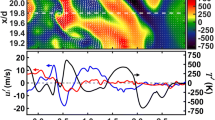Abstract
Tomographic particle image velocimetry (tomographic-PIV) is a recently developed measurement technique used to acquire volumetric velocity field data in liquid and gaseous flows. The technique relies on line-of-sight reconstruction of the rays between a 3D particle distribution and a multi-camera imaging system. In a turbulent flame, however, index-of-refraction variations resulting from local heat-release may inhibit reconstruction and thereby render the technique infeasible. The objective of this study was to test the efficacy of tomographic-PIV in a turbulent flame. An additional goal was to determine the feasibility of acquiring usable tomographic-PIV measurements in a turbulent flame at multi-kHz acquisition rates with current-generation laser and camera technology. To this end, a setup consisting of four complementary metal oxide semiconductor cameras and a dual-cavity Nd:YAG laser was implemented to test the technique in a lifted turbulent jet flame. While the cameras were capable of kHz-rate image acquisition, the laser operated at a pulse repetition rate of only 10 Hz. However, use of this laser allowed exploration of the required pulse energy and thus power for a kHz-rate system. The imaged region was 29 × 28 × 2.7 mm in size. The tomographic reconstruction of the 3D particle distributions was accomplished using the multiplicative algebraic reconstruction technique. The results indicate that volumetric velocimetry via tomographic-PIV is feasible with pulse energies of 25 mJ, which is within the capability of current-generation kHz-rate diode-pumped solid-state lasers.











Similar content being viewed by others
References
Adrian RJ (1991) Particle-imaging techniques for experimental fluid mechanics. Ann Rev Fluid Mech 23:261–304
Boxx I, Carter C, Meier W (2014) Investigation of turbulent lifted planar jet flames using highspeed laser imaging diagnostics, AIAA science and technology forum and exposition, national harbor, USA. AIAA-2014-0316
Coriton B, Steinberg AM, Frank JH (2014) High-speed tomographic PIV and OH PLIF measurements in turbulent reactive flows. Exp Fluids 55:1743
Elsinga GE, Scarano F, Wieneke B, van Oudheusden VW (2006) Tomographic particle image velocimetry. Exp Fluids 41:933–947
Gamba M, Clemens NT, Ezekoye OA (2013) Volumetric PIV and 2D OH PLIF imaging in the far-field of a low Reynolds number nonpremixed jet flame. Meas Sci Technol 24:024003
Ganapathisubramani B, Lakshminarasimhan K, Clemens NT (2008) Investigation of three-dimensional structure of fine scales in a turbulent jet by using cinematographic stereoscopic particle image velocimetry. J Fluid Mech 598:141–175
Ghaemi S, Scarano F (2010) Multi-pass light amplification for tomographic particle image velocimetry applications. Meas Sci Technol 21:127002
Ghaemi S, Scarano F (2011) Counter-hairpin vortices in the turbulent wake of a sharp trailing edge. J Fluid Mech 689:317–356
Han D, Su LK, Menon RK, Mungal MG (2000) Study of a Lifted-Jet Flame using a Stereoscopic PIV System, Proc. of the Tenth International Symposium on Applications of Laser Techniques to Fluid Mechanics, Lisbon, Portugal
Lecordier B, Gobin C, Lacour C, Cessou A, Tremblais B, Thomas L, David L (2012) Tomographic PIV study of lifted flames in turbulent Axisymmetric jets of methane, 16th Int Symp on Applications of Laser Techniques to Fluid Mechanics. Lisbon, Portugal
Maas HG, Gruen A, Papantoniou D (1993) Particle tracking velocimetry in three-dimensional flows. Part 1. Photogrammetric determination of particle coordinates. Exp Fluids 15:133–146
Muniz L, Martinez RE, Mungal MG (1996) Application of PIV to turbulent reacting flows, Proc. of the Eighth International Symposium on Applications of Laser Techniques to Fluid Mechanics, Lisbon, Portugal, pp 411–424
Muniz L, Mungal MG (1997) Instantaneous flame-stabilization velocities in lifted-jet diffusion flames. Combust Flame 111:16–31
Petersson P, Gesnik M, Olofsson J, Jaunet V, Aldén M (2013) Volumetric velocimetry in lifted turbulent premixed low-swirl flames, Proceedings of the European Combustion Meeting 2013, Paper P3-15, Lund, Sweden. ISBN 978-91-637-2151-9
Pfadler S, Beyrau F, Leipertz A (2007) Flame front detection and characterization using conditioned particle image velocimetry (CPIV). Opt Express 15444 15:23
Pfadler S, Dinkelacker F, Beyrau F, Leipertz A (2009) High resolution dual-plane stereo-PIV for validation of subgrid scale models in large-eddy simulations of turbulent premixed flames. Combust Flame 156:1552–1564
Pfadler S, Beyrau F, Dinkelacker F, Leipertz A (2010) A-priori testing of an eddy viscosity model for the density-weighted subgrid scale stress tensor in turbulent premixed flames. Exp Fluids 49:839–851
Prasad AK (2000) Stereoscopic particle image velocimetry. Exp Fluids 29:103–116
Raffel M, Willert CE, Kompenhans J (1998) Particle Image Velocimetry. A practical guide. Springer-Verlag, Berlin
Scarano F (2013) Tomographic PIV: principles and practice. Meas Sci Technol 24:012001
Schröder A, Geisler R, Elsinga GE, Scarano F, Dierksheide U (2008) Investigation of a turbulent spot and a tripped turbulent boundary layer flow using time-resolved tomographic PIV. Exp Fluids 44:305–316
Steinberg A, Driscoll J, Ceccio S (2009) Three-dimensional temporally resolved measurements of turbulence–flame interactions using orthogonal-plane cinema-stereoscopic PIV. Exp Fluids 47:527–547
Su LK, Sun OS, Mungal MG (2006) Experimental investigation of stabilization mechanisms in turbulent, lifted jet diffusion flames. Combust Flame 144:494–512
Violato D, Moore P, Scarano F (2010) Lagrangian and Eulerian pressure field evaluation of rod-airfoil flow from time-resolved tomographic PIV. Exp Fluids 50:1057–1070
Weinkauff J, Michaelis D, Dreizler A, Böhm B (2013) Tomographic PIV measurements in a turbulent lifted jet flame. Exp Fluids 54:1624
Westerweel J, Scarano F (2005) Universal outlier detection for PIV data. Exp Fluids 39:1096–1100
Wieneke B (2008) Volume self-calibration for 3D particle image velocimetry. Exp Fluids 45:549–556
Acknowledgments
This work was supported by the Air Force Office of Scientific Research (AFOSR) and The European Office of Aerospace Research & Development (EOARD) through Grant FA8655-12-1-2092.
Author information
Authors and Affiliations
Corresponding author
Rights and permissions
About this article
Cite this article
Boxx, I., Carter, C.D. & Meier, W. On the feasibility of tomographic-PIV with low pulse energy illumination in a lifted turbulent jet flame. Exp Fluids 55, 1771 (2014). https://doi.org/10.1007/s00348-014-1771-z
Received:
Revised:
Accepted:
Published:
DOI: https://doi.org/10.1007/s00348-014-1771-z




